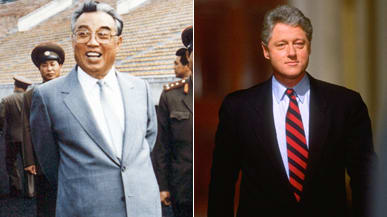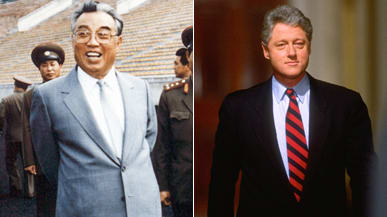It was a tense scene in the White House cabinet room. On June 16, 1994, Defense Secretary William Perry and Joint Chiefs Chairman John Shalikashvili were briefing President Clinton and his National Security Council on options for defending South Korea against the distinct possibility North Korea might soon attack.

"We knew we were poised on the brink of a war that might involve weapons of mass destruction," Perry recalled in his 1999 book, Preventive Defense. "When the president entered the room he was more somber than usual; indeed everyone there recognized the gravity of the situation."
Just two days earlier Perry had huddled with his military commanders over a plan to launch a surprise attack, against the small nuclear reactor at Yongbyon, to prevent North Korea from recovering the raw material to make nuclear weapons.
With tensions escalating at the heavily fortified border after a North Korean artillery barrage Tuesday killed two South Korean marines, this nearly forgotten history is worth recalling.
All-out war on the Korean peninsula is a scenario the Pentagon has spent more than half a century war-gaming.
The U.S. strategy 16 years ago called for a combination of unmanned cruise missiles, and small single-seat F-117 fighters to bomb the plant. It was, in Perry's assessment, an "impressive plan" that could be carried out with just a few days notice, and involved little risk of U.S. casualties, at least during the attack. But after the attack, all bets were off. That held the possibility of the nightmare scenario: all-out war on the Korean peninsula.
In a 1999 interview two years after he left the Pentagon, Perry told me he was convinced the U.S. could have taken out the Yongbyon facility without the risk of nuclear contamination, but said he didn't brief that option to Clinton that day. "I concluded that was too likely to start a war," Perry told me. Instead, he kept those plans in reserve, an ace-in-the-hole, if tough new sanctions failed to bring Pyongyang around.
• Leslie H. Gelb: The Next Korean War?All-out war on the Korean peninsula is a scenario the Pentagon has spent more than half a century war-gaming. Invariably the U.S. and South Korean forces prevail, but always at a heavy cost, including a predicted minimum of 1 million casualties, military and civilian, on both sides. It is what the Pentagon calls a "major regional conflict" that would tax the resources of the U.S. military, even if it weren't bogged down in two other major wars, as it is today.
So, on that warm June morning, fearful that an offensive strike could spell disaster, Perry was pushing a middle option: tougher U.N. sanctions which, while less provocative, also carried a high risk. As Perry warned the president at the time, North Korea's aging leader Kim Il Sung was capable of acting irrationally if backed into a corner, even against his own interest, and there had already been ominous warnings that new sanctions would be seen by Pyongyang as "equivalent to an act of war."
Robert Gallucci, who was the chief U.S. negotiator during the 1994 crisis, recalled in an interview five years later, “I had been personally been told, by the North Korean head of the delegation that a sanctions resolution, and actions to implement could well be taken as an act of war, given that the U.N. was a belligerent in the Korean War and there was an armistice in place. They would regard it therefore as a violation of the Armistice. It seemed quite plausible to me."
Perry laid out three options to substantially reinforce the 37,000 U.S. troops already in Korea. The Pentagon was advocating a “middle option”; moving 10,000 more troops, along with F-117s, long-range bombers, and an additional aircraft carrier battle group to Korea or nearby, while evacuating some American citizens from Seoul, which was in easy artillery range 40 miles south of the DMZ. And North Korea has an estimated 11,000 guns along the border capable of raining as many as 300,000 shells an hour on the South Korean capital.
At the time there was a real fear North Korea would read the build-up and evacuations as certain signs of an impending attack, and launch a preemptive invasion. U.S. intelligence analysts believed the North Koreans took one main lesson from the 1991 Persian Gulf War: Don’t give the United States time to build up its forces.
Perry told Clinton that while all the options were unpalatable, failure to pick one would be disastrous. Perry didn't want war, but it looked like it was coming, one way or another. “I believe that would have been a step in that direction, and with each step it would have been harder to pull back," Ambassador Gallucci recalled in 1999. “This is sometimes called a sort of '1914 syndrome,' where two sides intending to protect against the other's surprise attack, in fact, move a situation to where both sides come closer to war.”
As in a Hollywood movie script, just as the president was about to pick his poison, there came a reprieve. “My recollection is that before the president got to choose," Gallucci says, "the door of the room opened and we were told that there was a telephone call from former President Carter in Pyongyang, and that he wished to speak to me.”
Jimmy Carter had been meeting as a private citizen with Kim Il Sung, and was calling to report a breakthrough. The White House session broke up, and relieved officials watched on CNN as Carter reported the results of his mission to the world, by telephone from Pyongyang.
Over the next few days, North Korea agreed to freeze its nuclear program in return for new nuclear reactors that didn’t produce weapons-grade plutonium, along with oil to help meet to its energy needs. That was the so-called framework agreement that—while defusing the crisis—also allowed the North Koreans to cloak their covert nuclear program until they could build a working bomb. So while war was averted in 1994, the very "disaster" that Secretary Perry desperately wanted to prevent came to pass 12 years later: North Korea is now armed with at least rudimentary nukes.
Now South Korea is again facing acts of provocation from the North, which insists on seeing every defensive military exercise as an offensive threat. One thing to keep in mind as events unfold: Should the North ever attack the South, there will be no national debate in the U.S. over whether to join the battle. America is already committed by treaty to defend the South and an American general is commanding the combined U.N. forces, (basically the U.S. and South Korea). If war starts, it could be over in as little as a few weeks, given America's superior military might, but it could also be bloody on a scale that far exceeds Iraq or Afghanistan—especially if the North can figure out how to get a nuclear weapon into the mix.
Jamie McIntyre is the former senior Pentagon correspondent for CNN, and an adjunct professor of journalism at the University of Maryland. He blogs on military and media issues at "Jamie McIntyre's Line of Departure," lineofdeparture.com.

